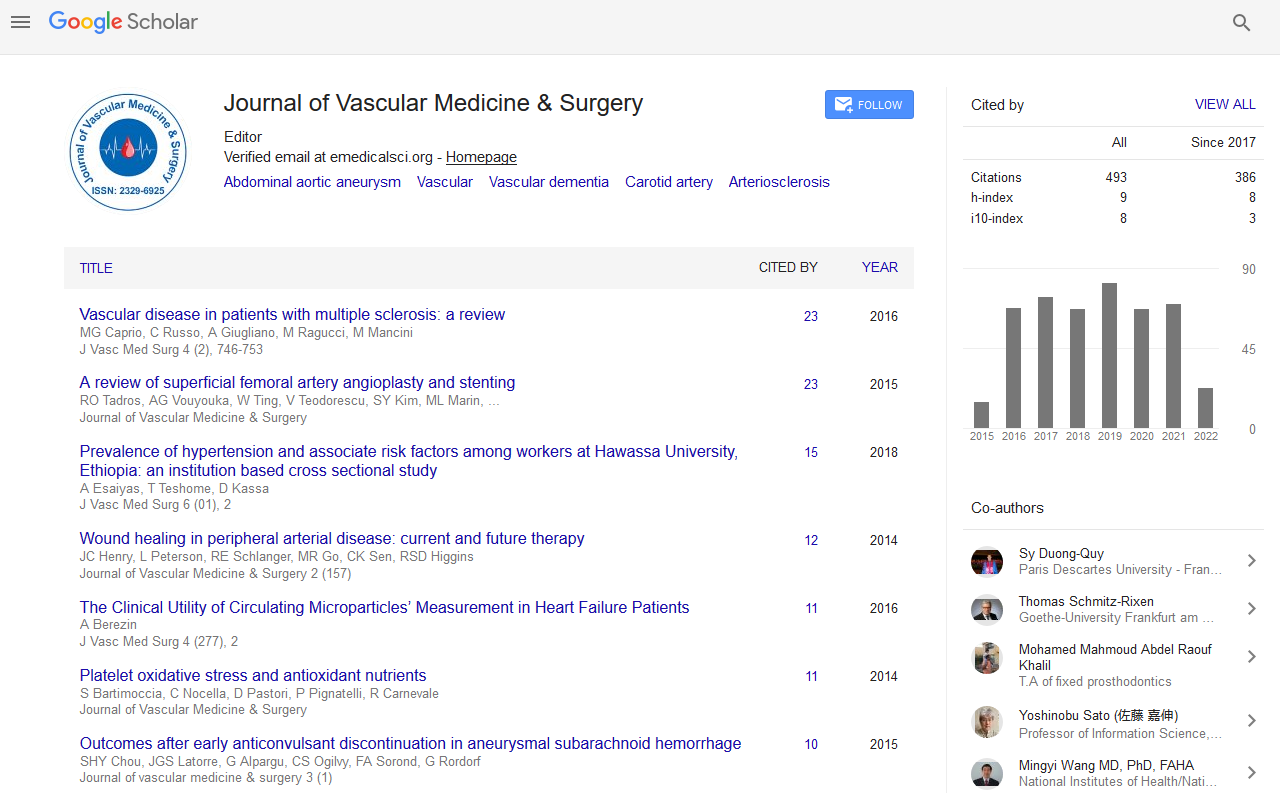Indexed In
- Open J Gate
- Academic Keys
- RefSeek
- Hamdard University
- EBSCO A-Z
- OCLC- WorldCat
- Publons
- Euro Pub
- Google Scholar
Useful Links
Share This Page
Journal Flyer

Open Access Journals
- Agri and Aquaculture
- Biochemistry
- Bioinformatics & Systems Biology
- Business & Management
- Chemistry
- Clinical Sciences
- Engineering
- Food & Nutrition
- General Science
- Genetics & Molecular Biology
- Immunology & Microbiology
- Medical Sciences
- Neuroscience & Psychology
- Nursing & Health Care
- Pharmaceutical Sciences
Editorial - (2021) Volume 0, Issue 0
Aligning Orifice of the Renal artery: Editorial
Received: 04-Jun-2021 Published: 25-Jun-2021, DOI: 10.35248/2329-6925.21.s6.e002
Editorial Note
The renal arteries are paired arteries that supply the kidneys with blood. Each is directed across the crus of the diaphragm, so as to form nearly a right angle. The renal arteries carry a large portion of total blood flow to the kidneys. Up to a third of total cardiac output can pass through the renal arteries to be filtered by the kidneys. Intense renal dead tissue (ARI) is an uncommon sickness with atrial fibrillation being its fundamental driver. The conceivable laterality of ARI is disputable. This investigation planned to assess the relationship between anatomical highlights of the renal courses and ARI.
Varieties in the blood vessel, venous, and ureteral designing of the right (r) and left (l) kidneys are normal; nonetheless, corresponding inclusion with each of the three frameworks is uncommon. Examples that exhibit anatomic variety across numerous frameworks give a chance to outline joins between anatomic ideas, embryologic turn of events, clinical practice, and instruction. During anatomic investigation of the stomach depression, an aggregate of five significant conduits (3l and 2r) rose up out of the aortic and normal iliac tomahawks in a cadaveric contributor. Through proceeded with study, numerous contributing veins, of various type, blended into four significant renal veins (2l and 2r) that returned blood from the kidneys to the substandard vena cava (IVC) at various areas. Also, one-sided duplication of the kidney with associative ureters was clear on the right side. The two ureters proceeded poorly and autonomously entered the bladder, each with a recognizable hole contiguous the bladder trigone. Generally obvious in the example was the anteriorly coordinated hilum for the two kidneys. Announced measures for every one of the noticed anatomic varieties propose that the current example has an expected rate of under 0.3%. This relatively uncommon example gives an illustration of significant anatomic ideas that are pertinent to instructive and clinical practices.
Renal Artery
The renal veins are matched courses that supply the kidneys with blood. Each is coordinated across the crus of the stomach, in order to shape almost a right point.
The renal corridors convey an enormous part of complete blood stream to the kidneys. Up to 33% of all out heart yield can go through the renal courses to be separated by the kidneys.
The renal courses regularly emerge at a 90° point off of the left inside side of the stomach aorta, quickly beneath the prevalent mesenteric corridor. They have a range of roughly 0.25 cm, 0.26 cm at the root. The deliberate mean breadth can vary contingent upon the imaging technique utilized. For instance, the width was discovered to be 5.04 ± 0.74 mm utilizing ultrasound yet 5.68 ± 1.19 mm utilizing angiography.
Because of the anatomical situation of the aorta, the substandard vena cava, and the kidneys, the right renal corridor is typically more than the left renal conduit.
Prior to arriving at the hilus of the kidney, every supply route isolates into four or five branches; the more noteworthy number of these (foremost branches) lie between the renal vein and ureter, the vein being in front, the ureter behind, however at least one branches (back branches) are generally arranged behind the ureter.
Every vessel radiates some little substandard suprarenal branches to the suprarenal organ, the ureter, and the encompassing cell tissue and muscles.
A couple of adornment renal corridors are habitually discovered, particularly on the left side since they normally emerge from the aorta, and may fall off above (more normal) or underneath the primary vein. Rather than entering the kidney at the hilus, they generally penetrate the upper or lower part of the organ.
Citation: Chawla H (2021) Aligning Orifice of the Renal Artery. J Vasc Med Surg. S6:e002.
Copyright: © 2021 Chawla H. This is an open-access article distributed under the terms of the Creative Commons Attribution License, which permits unrestricted use, distribution, and reproduction in any medium, provided the original author and source are credited.


